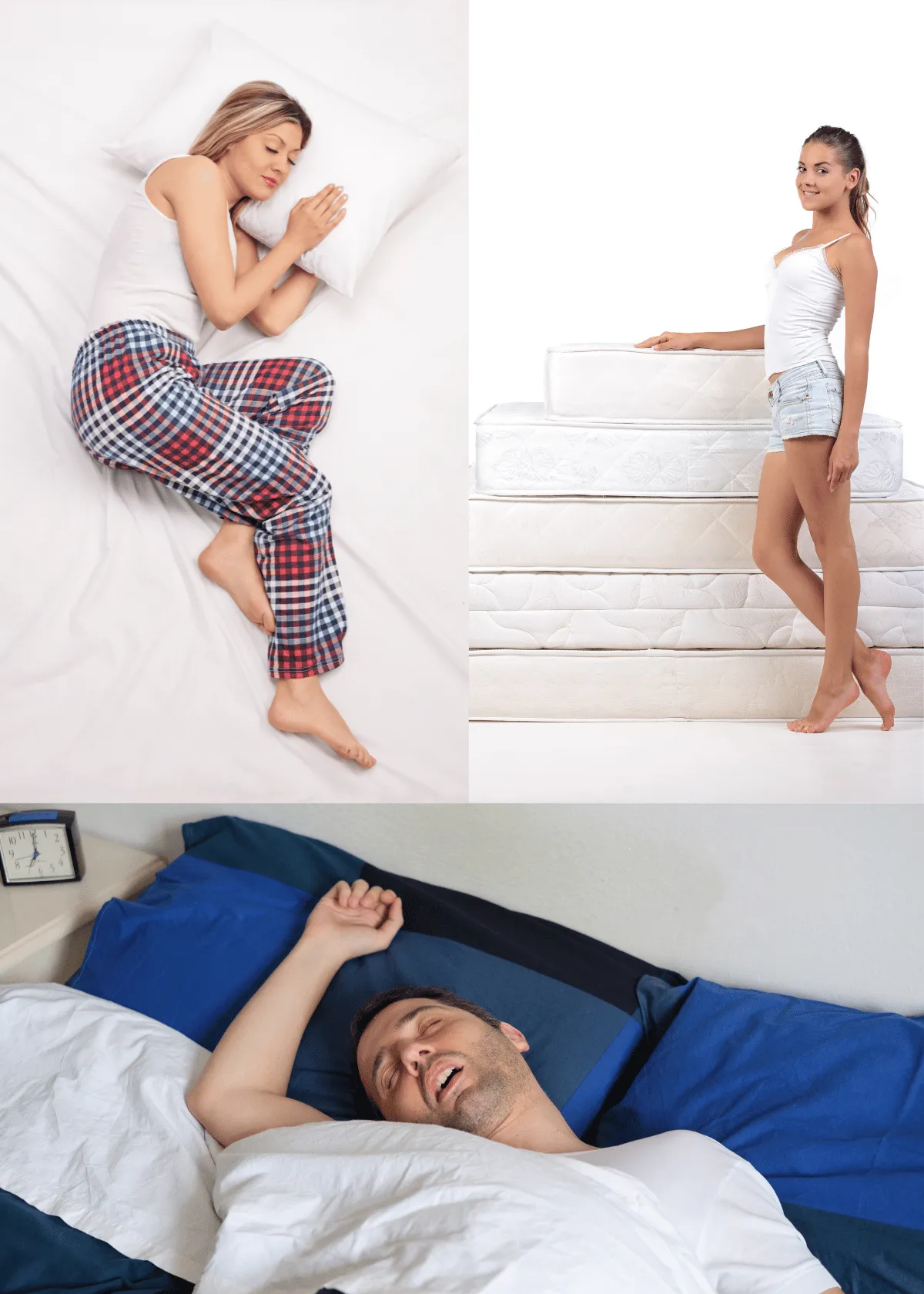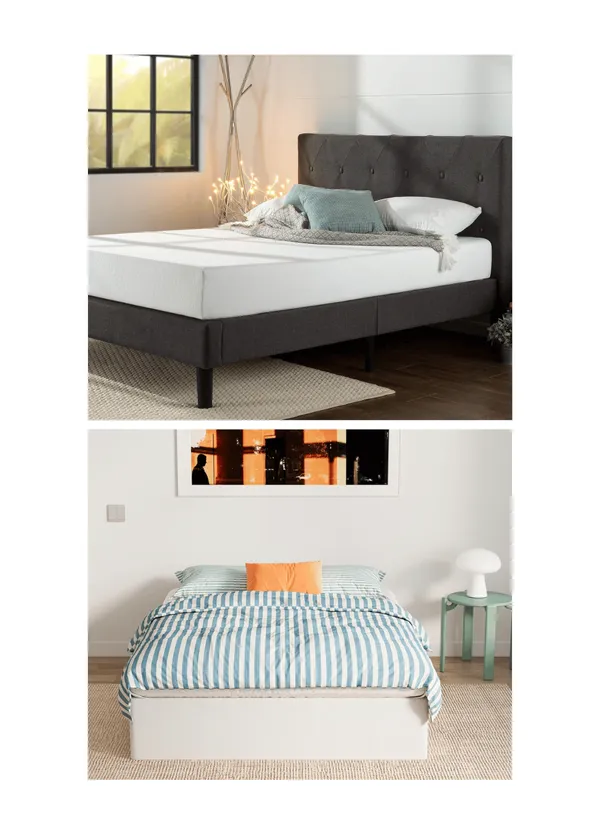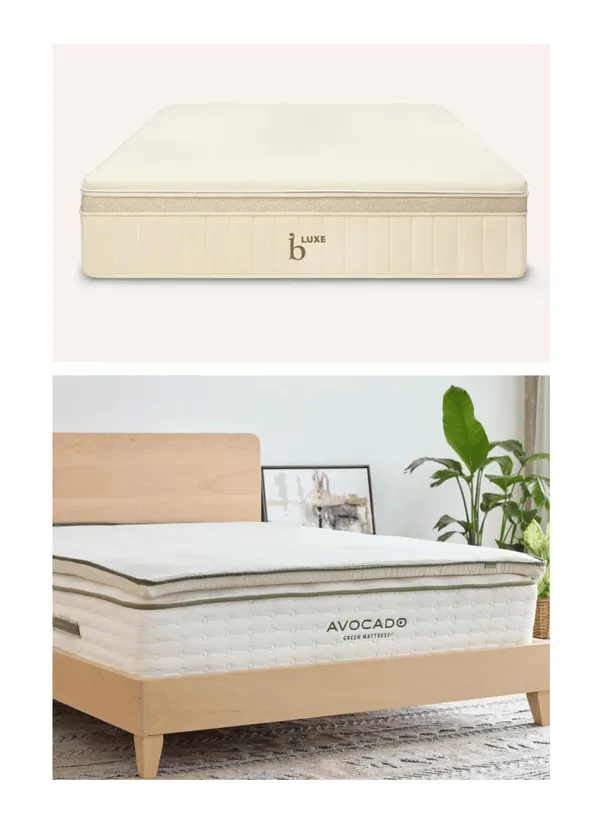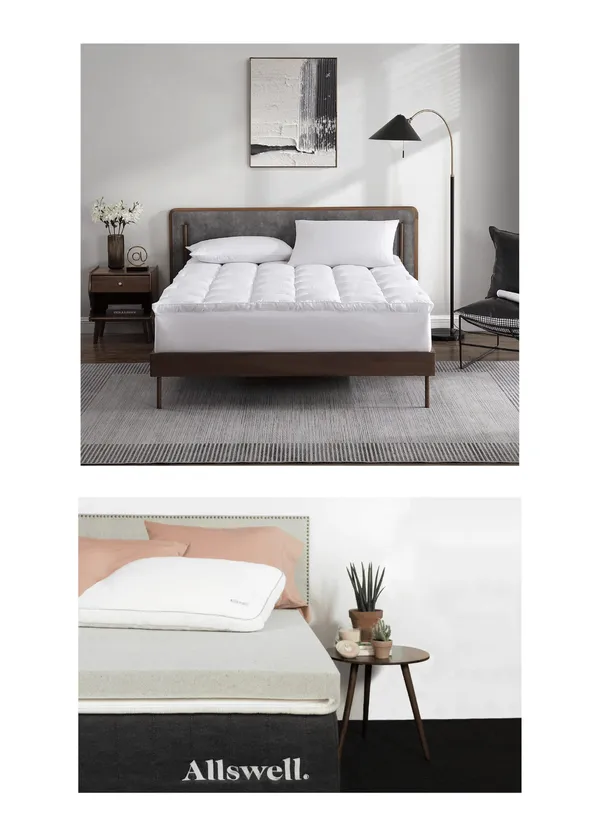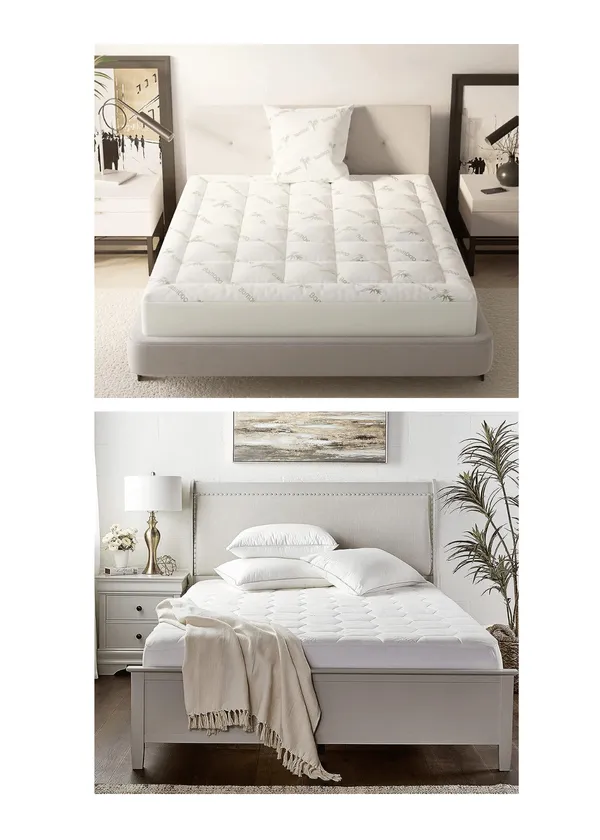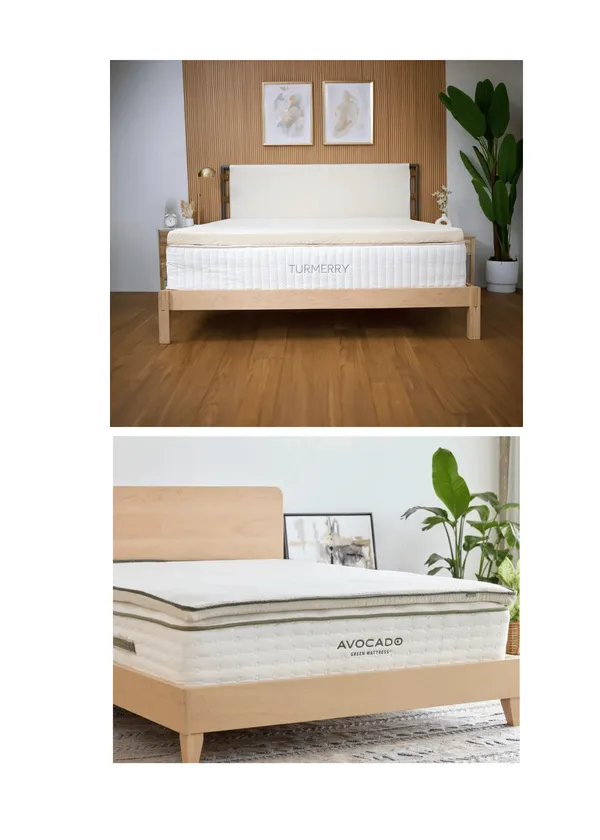(Last Update: 05/24/2024)
A good night's sleep is not just a luxury, it's a necessity for our overall health and well-being. And the key to achieving that lies in finding the perfect mattress.
But how do you find that elusive perfect mattress? We do so by understanding the mattress industry and sleep science, focusing on sleep efficiency with the best studies on comfort and health.
This comprehensive guide will explore different mattress types, their benefits, and expert recommendations to help you make an informed decision and unlock the secret to the best night's sleep.
Key Takeaways
- Research has determined the importance of mattresses for back pain relief, customized mattresses for individual comfort, and temperature control in improving sleep quality.
- When selecting a mattress to meet one's needs, consider personal factors such as sleep position, body type, and health conditions.
- Evaluate mattress durability and warranty to ensure investment in good sleep health that will last.
Section 1: The Science Behind Mattress Comfort
What the Sleep Scientists Are Saying About Sleep and Mattress
Dr. Matthew Walker, Neuroscientist and Psychologist

Dr. Matthew Walker
(Credit: University of California, Berkeley)
Matthew Walker, a distinguished professor of neuroscience and psychology at the University of California, Berkeley, is a highly respected authority in sleep science. His prolific contributions, including the New York Times bestseller "Why We Sleep," affirm his proficiency and deep knowledge of sleep mechanisms.
Walker's theory of sleep underscores its indispensability for learning, memory, and overall health. He posits that sleep assists the brain in consolidating memories and eliminating toxins that accumulate throughout the day, making it essential for cognitive functionality.
He frequently emphasizes the role of a proper sleep environment in achieving high-quality sleep. Walker particularly points out the significance of a comfortable mattress. According to him, a good mattress helps to fall asleep faster and enhances sleep quality.
Walker's book "Why We Sleep: Unlocking the Power of Sleep and Dreams" (2017) includes the thought-provoking perspective that a mattress represents one of the most important investments due to the amount of life spent.
He suggests that mattress quality, influenced by material type, impacts sleep quality and comfort. He highlights memory foam, hybrid, and gel-infused memory foam mattresses as popular choices that offer unique benefits, such as pressure relief and spinal alignment, promoting restful snoozes.
Dr. Richard Ferber, Sleep pediatrician

Dr. Richard Ferber
(Credit: Harvard University)
Dr. Charles Czeisler, a noteworthy figure in the field of sleep science, significantly contributes to understanding sleep environments. Although not directly focused on mattresses, his wide-ranging research underscores their integral role in creating a conducive sleep setting.
Czeisler's theory of sleep revolves around the human "body clock." He suggests an optimal sleep environment, including a comfortable mattress, is vital for maintaining this internal rhythm and enhancing sleep quality.
While Czeisler does not explicitly focus on mattresses, he acknowledges their contribution to sleep quality. He emphasizes the impact of a good mattress and advocates for a change if one's current mattress hampers restful sleep.
In line with Czeisler's perspective, evaluating a mattress involves considering its comfort, pressure relief, support, and potential for improving sleep quality.
According to Czeisler's theory, understanding the unique benefits of different mattress types can help identify the ideal mattress to suit individual needs and preferences, thereby promoting peaceful, high-quality sleep.
Dr. Charles Czeisler, Sleep Scientist

Dr. Charles Czeisler
(Credit: Harvard University)
Memory Foam and Pressure Relief
- Understanding Memory Foam and its Role in Pressure Relief
Viscoelastic mattresses have surged in popularity due to their unique ability to relieve pressure and support. This distinctive characteristic allows the foam to mold to the body's shape, evenly distributing body weight.
This action reduces pressure points and ensures appropriate spinal orientation. However, traditional foam has its downsides—it's known for retaining heat, which can make sleeping hot uncomfortable.
- Exploring Innovations in Memory Foam Design
Innovative designs, such as gel-infused foam, copper-infused foam, and Euro-top styles, have been introduced to overcome heat retention.
These advanced foam versions incorporate elements that enhance temperature regulation and provide cooling properties, helping trap heat to offer a more comfortable sleep experience.
- Personal Factors and Foam Selection
Personal factors such as sleeping position and body weight should be considered when choosing a foam mattress to ensure optimal comfort and support. Evaluating the durability and warranty of the mattress is equally important. These factors contribute to the overall value and longevity of your investment.
- Memory Foam for Specific Sleep Needs
Due to its unique pressure relief and support, memory foam mattresses suit many sleepers.
Sleepers can find the ideal mattress by considering individual needs, preferences, and the different foam options. The right choice will ensure a restful night’s snooze, contributing to overall health and well-being.
Harnessing the Benefits of Memory Foam
Foam beds offer an unparalleled balance of comfort and support. Whether dealing with a specific sleeping issue or merely seeking a better night's sleep, exploring the benefits of different Viscoelastic mattresses could significantly improve your subjective sleep quality and overall quality of life.
Considering your unique needs and preferences, you can find the perfect foam mattress that provides comfort and lasting value.
Hybrid Mattresses and Spinal Alignment
- A Confluence of Comfort and Support
Hybrid mattresses are an intriguing choice for those pursuing improved sleep quality. They ingeniously blend the best aspects of memory foam and innerspring construction to provide a well-balanced sleeping surface.
The pressure-relieving benefits of foam complement the robust support of innerspring construction, making hybrid mattresses a desirable option for individuals aiming to maintain proper spinal orientation and enhance overall comfort.
- The Dual Benefits of a Hybrid Mattress
Thanks to the intelligent pairing of foam layers and pocketed coils, a hybrid mattress sets itself apart with responsiveness and deep cushioning. The solid support from the core of pocketed coils offers enhanced backing for the lower back and hips.
At the same time, the foam and coil layers allow for deeper contouring around the shoulders and hips. The result is optimal spinal alignment and reduced pressure points, paving the way for a more peaceful and refreshing sleep experience.
- Catering to Varied Sleep Preferences
Today's market offers an array of hybrid mattresses, each presenting unique features and benefits tailored to various sleep preferences and needs. Some renowned examples include the Saatva Classic, Helix Dusk Luxe, WinkBed, and Purple Hybrid mattresses.
By comprehending the distinct advantages of a bed like the Layla hybrid mattress, particularly spinal orientation, sleepers can make a more informed decision when choosing the perfect one.
- Individual Sleep Preferences
In conclusion, a hybrid mattress provides a unique balance of comfort and support, making it an ideal choice for those seeking proper spinal alignment and restful sleep.
You can pinpoint the ideal mattress by exploring the various hybrid options and considering your sleep preferences. The right choice will enhance your sleep quality and contribute to your overall well-being.
- The Pathway to Enhanced Sleep and Spinal Health
Combining the benefits of innerspring and memory foam beds, choosing a hybrid mattress can be a game-changer for those seeking better sleep and improved spinal health.
By understanding and evaluating the various options in this category, you can choose a hybrid mattress that fits your unique sleep preferences, offering you a more restful night's snooze and better overall health.
Gel-infused memory Foam for Temperature Regulation
- Revolutionizing Comfort
Foam mattresses are renowned for being different from beds with poor pressure relief and support. Still, heat retention is one of their key challenges. Recognizing this issue, manufacturers have innovated with foam, a material that maintains traditional foam's comfort and support while offering superior temperature regulation.
This innovative foam integrates cooling gel beads that facilitate heat dissipation, leading to a noticeably cooler sleep surface. The enhanced airflow and cooling properties significantly minimize heat retention, ensuring a more comfortable and restful sleep experience.
In addition to these cooling benefits, the foam helps reduce motion transfer, making it an ideal choice for couples.
Utilizing Gel-Infused Firm or Medium-Firm Memory Foam
Numerous mattresses in the contemporary market incorporate foam to address temperature regulation. These include the Saatva Classic, Purple Hybrid, DreamCloud, Softer WinkBed, Nolah Evolution 15, Bear Elite Hybrid mattress, and Aurora Luxe mattress.
Opting for a smart bed with foam enables sleepers to enjoy the pressure-relieving benefits of foam without the heat retention drawbacks usually associated with this material.
- The Impact of Gel Foam on Sleep Quality
Viscoelastic mattresses transform sleep quality, particularly for hot sleepers worried about traditional memory foam's heat retention issues.
Consider the various gel memory foam mattress options and their temperature-regulating benefits to choose the ideal mattress for a restful and refreshing night's sleep.
- Innovative Material, Better Sleep
In conclusion, polyfoam mattresses offer a cooler and more comfortable sleep experience by addressing heat retention—one of the primary concerns related to traditional gel-infused memory foam beds.
A gel-infused foam mattress could be the perfect solution for hot sleepers or those worried about traditional foam's warmth.
By carefully assessing your individual sleep preferences and understanding the cooling benefits of foam, you can select a smart bed that ensures a good night's sleep and contributes to your overall well-being.
Section 2: Sleep Health and Mattress Selection
- The Role of Mattresses in Sleep Health
The significance of sleep health to overall well-being is undeniable, and your choice of mattress plays a substantial role.
Selecting a mattress that suits your sleeping position and personal requirements can address various issues, such as dorsal pain. This personalized choice can enhance sleep quality and boost your health.
- Understanding Mattress Types
The first stage in choosing an apt mattress for sleep health involves learning about the different types and their advantages. Memory foam, latex, and spring mattresses offer distinct benefits such as pressure alleviation, breathability, and support.
Gaining insight into the strengths of each mattress type enables you to make an informed decision reflecting your specific needs and sleep preferences.

(Credit:Molblly)
Role of Mattress Toppers in Sleep Health
Enhancing Sleep Onset Latency
Mattress toppers significantly improve sleep onset latency, the time it takes to fall asleep. A high-quality mattress topper can help create a more inviting sleep surface by providing additional comfort and support, reducing the time it takes for the body to relax and drift off to sleep.
Supporting Preferred Sleep Position
A well-chosen mattress topper can accommodate your preferred sleep position, whether you're a back, side, or stomach sleeper. It offers support and cushioning to maintain proper spinal alignment and reduce discomfort, leading to more restful and uninterrupted sleep.
Improving Body Pressure Distribution
Mattress toppers also help distribute body pressure better. They can alleviate pressure points and distribute body weight more evenly across the sleep surface, reducing the likelihood of aches and pains. This improved distribution enhances overall sleep quality and contributes to better sleep health.
Research Insights: Mattress Comfort, Health, and Sleep Quality
Many studies have scrutinized the link between mattress comfort, health, and sleep quality. These research endeavors have revealed that medium-firm mattresses are optimal for relieving dorsal pain, customized mattresses cater to personal comfort, and mattresses with temperature control capabilities enhance sleep quality.
These findings can guide you towards a more educated mattress choice that nurtures your sleep health and overall wellness.
This study found that individuals who used a medium-firm mattress reported less back pain upon waking and during the day than those who used firm mattresses.
This study suggests that medium-firm beds can better distribute body pressure, alleviating back pain and improving sleep quality.
This study explored the impact of customized mattresses on sleep quality and pain. The researchers found that participants who used beds tailored to their preferences and needs experienced better sleep quality and reduced back discomfort than their usual mattresses.
This finding underscores the importance of individual comfort and support in enhancing sleep quality and reducing pain.

(Credit: Sealy)
Personal Factors and Mattress Selection
Lastly, experts suggest contemplating personal factors, balancing comfort and support, and assessing mattress durability and warranty during your smart bed selection process.
By heeding these considerations and meticulously evaluating your individual needs, you will be equipped to sleep comfortably. This will improve your sleep health and ensure a blissful and restful night's snooze.
Sleep Position and Mattress Firmness
Sleep Position: A Critical Determinant of Mattress Firmness
Your sleeping position is vital in identifying the dream mattress's firmness to provide ultimate comfort and support. Typically, side sleepers favor softer mattresses, while those who sleep on their backs or stomachs are more inclined towards firmer ones.

Blissful Nights Adjustable Mattress
(Credit: Blissful Nights)
Choosing a mattress with the correct firmness for your sleeping position can assure proper spinal orientation and diminish the risk of aches and pains, enhancing your sleep health.
- The Ideal Mattress for Side Sleepers
A medium-soft to medium-firm feel mattress is typically recommended for side sleepers. This firmness level allows for adequate support and cushioning of pressure points like the hips and shoulders.
Minimizing these pressure points ensures a more comfortable and restful slumber experience. Several mattresses are specifically designed for side sleepers, with examples including the DreamCloud mattress and the Softer WinkBed.
The best mattresses are engineered to the specific needs of side sleepers, combining comfort and support for a peaceful night's sleep.

Sleep Innovation Mattress
(Credit: Sleep Innovation)
- Understanding Mattress Needs for Back and Stomach Sleepers
Unlike side sleepers, back and stomach sleepers usually require a firmer mattress. This firmness level provides the needed support for the spine and helps prevent midsection sagging that could lead to discomfort or pain.
The Aurora Luxe's firm model and the Luxury Firm WinkBed are well-suited mattresses for back and stomach sleepers. They offer the necessary support to maintain spinal alignment and promote better sleep health.
The Link Between Sleep Position and Mattress Firmness: A Guide to Better Sleep Health
In conclusion, grasping the relationship between sleeping position and mattress firmness is pivotal to finding the dream mattress that enhances sleep health.
Please consider your primary sleep position and select a mattress with an appropriate firmness level to get a comfortable and restful night's sleep.
By prioritizing both comfort and support, you'll be investing not just in restful nights but also in long-term health and well-being.

Lucid Mattress
(Credit: Lucid)
Addressing Sleep Apnea with Mattress Choice
- The Importance of Mattress Choice
Sleep-related breathing disorder is a prevalent disorder affecting sleep quality and overall health. Selecting the right mattress can alleviate apnea symptoms, enabling improved breathing and more restful slumber.
The Role of Sleep Positions in AlleviatingSleep-related Breathing Disorder
Choosing a mattress that offers sufficient support for side sleeping can be particularly beneficial for those with Sleep-related apnea.
Side sleeping helps keep the airway open, resulting in easier breathing. This emphasizes the importance of selecting a mattress designed to enhance the comfort of side sleepers.

Saatva Classic Mattress
(Credit: Saatva)
- Advantages of Adjustable Bed Bases for Sleep-disordered Breathing
Further to the best mattress choice, adjustable bed bases that allow for head elevation during sleep can be particularly beneficial.
Elevating the head can reduce snoring and airway blockage, improving sleep quality for apnea patients. An adjustable bed like the Purple PowerBase offers a zero gravity setting for optimal comfort.
- Ideal Mattress Firmness for Sleep-related Breathing Disorder People
Typically, a firmer mattress is preferable for individuals with Sleep-related apnea. The recommended firmness ranges from medium to medium-firm.
The best mattresses offer customizable firmness and support, such as the Sleep Number bed c4, or those noted for their comfort and effectiveness in managing Sleep-related apnea symptoms, like the p6 mattress, can be beneficial.
Indeed, Sleep Number mattresses offer unparalleled customization for enhanced sleep quality. Sleep Number beds provide targeted support and pressure point relief using unique air chamber technology. Sleep Number 360 smart beds feature a sleep-tracking app via SleepIQ technology.
Renowned for promoting optimal spine alignment and sleep wellness, Sleep Number is an industry standout. Investing in a Sleep Number mattress means investing in personalized, advanced comfort for a better slumber experience.

Bear Elite Mattress
(Credit: Bear)
- The Positive Impact of Right Mattress Choice on Sleep-disordered Breathing
The right mattress can significantly address Sleep-disordered breathing and enhance overall sleep quality. By considering your preferred sleeping positions and selecting a mattress that provides the necessary support and firmness, you can mitigate Sleep-related apnea symptoms and ensure a more restful night's slumber.
It underscores mattress choice's integral role in managing sleep disorders and promoting better sleep health.
Reducing Back Pain with the Right Mattress
- Addressing Back Pain Through Mattress Selection
Back pain is a prevalent issue that can significantly influence sleep quality and overall wellness.
The right mattress can alleviate dorsal pain by offering the necessary spinal support and promoting a neutral posture during sleep, demonstrating your mattress's essential role in sleeping and comfortably managing physical discomfort.

Brooklyn Mattress
(Credit: Brooklyn Bedding)
- Spinal Support and Mattress Characteristics
The link between reduced back pain and mattress properties lies in the mattress's capacity to align the spine correctly.
The best mattresses can mitigate dorsal pain by supporting body pressure and natural spinal curvature. Studies indicate that medium-firm to firm mattresses are typically the best choice for reducing back pain, as they provide the required spinal support while remaining comfortable.
- Sleep Positions, Spinal Alignment, and Mattress Choice
Considering your sleeping position and spinal alignment when selecting a mattress is critical. A mattress that suits your sleep position and provides comfort and support for your unique needs can significantly improve sleep quality.
For instance, Viscoelastic mattresses with additional lumbar support are often considered the most beneficial for individuals experiencing back pain.
- Role of Viscoelastic Mattresses in Alleviating Back Pain
A memory foam mattress is popular for individuals with dorsal pain. These mattresses conform to the body's contours, offering pressure-relieving points and support where needed.
Some Polyfoam mattresses have additional lumbar support, which provides extra relief to the lower back region, often a problematic area for back pain sufferers.
- Making the Right Mattress Choice for Back Pain Relief
In conclusion, choosing the right mattress can greatly reduce back pain and enhance sleep quality. Understanding the relationship between mattress characteristics and dorsal pain and considering your individual sleep preferences allows you to select the dream mattress to alleviate discomfort and facilitate a restful night's slumber. This choice underscores personal comfort and mattress quality's significant role in managing back pain. S

Sven & Son Mattress
(Credit: Sven & Son)
Section 3: Key Mattress Types and Their Benefits
As you embark on your journey to find the ideal sleep solution, you must understand the key mattress types and their benefits. Memory foam, latex foam, and innerspring beds are the primary types, each offering unique advantages that cater to varying needs and preferences.
By familiarizing yourself with these mattress types, you can make a more informed decision when selecting the ideal mattress for your sleep health and comfort.
Memory Foam Mattresses
- The Unmatched Comfort of Polyfoam Mattresses
Viscoelastic mattresses are renowned for their superior pressure relief and support. They conform to the body's contours and evenly distribute weight.
This unique foam attribute alleviates pressure points, ensuring correct spinal orientation and a comfortable slumber.
Viscoelastic mattresses come in diverse designs and materials, enhancing the snooze experience by catering to individual preferences.
- Exploring Varieties of Foam Mattresses
Viscoelastic mattresses offer improved temperature regulation and are available in various types, including hybrid foam, polyfoam, and even foam.
The range of options caters to different sleeping styles, individual body types, and comfort preferences, enabling sleepers to find the ideal slumber solution for their unique needs.
- Understanding the Quality of Foam Mattresses
However, it's critical to recognize that not all memory foam beds are created equal. The longevity and comfort of a Polyfoam mattress can significantly vary based on the foam's composition and quality.
Therefore, factors such as the foam attribute density and overall construction should be considered when choosing a foam mattress to ensure you select a high-quality product.
Dr. Michael Breus, Clinical Psychologist and Diplomate of the American Board of Sleep Medicine, has written extensively about sleep, including the role of foam beds in promoting better sleep.
He notes that foam can benefit those with back and joint pain by distributing weight evenly and reducing pressure points. The right foam mattress can also help regulate body temperature, improving sleep for those who tend to sleep hot.
Reference: Breus, Michael J. (2020). "How to Choose a Mattress: A Buyer’s Guide." The Sleep Doctor. Available at:https://thesleepdoctor.com/2020/02/17/how-to-choose-a-mattress-a-buyers-guide/
- Highlighting Popular Memory Foam beds
Numerous foam beds on the market cater to different needs and preferences. Notable examples include the Helix Plus, a memory foam hybrid, and the Nectar mattress, which boasts a 2-inch comfort layer of foam over transitional and support foam layers of denser polyfoam. The materials and the mattress's construction can guide you to the perfect foam mattress.
Dr. Rebecca Robbins, a Postdoctoral Fellow at Brigham and Women’s Hospital and Harvard Medical School, has extensively studied sleep health and provided insight into the role of the best mattresses in sleep quality.
In an article with Mattress Clarity, Dr. Robbins discusses how memory foam beds can benefit sleep, stating, "Viscoelastic Mattresses are known for their pressure-relieving features—they can help to evenly distribute the sleeper's weight and conform to their body's shape."
She adds that this can be particularly beneficial for side sleepers who often experience shoulder and hip pressure points. However, she also emphasizes that the firmness level of the new mattress should be considered, as other mattresses that are too soft or too firm can lead to discomfort and poor sleep quality.
Reference: Gomez, Marten. (2020). "What Type of Mattress is Best for You? A Look at the Pros and Cons of Mattress Types." Mattress Clarity. Available at: https://www.mattressclarity.com/blog/what-type-of-mattress-is-best-for-you/
- Informed Decisions for Optimal Sleep Comfort
In summary, memory foam beds offer unparalleled pressure relief and support, making them popular among sleepers.
By understanding the various types of foam beds available and their unique properties, you can make a well-informed decision and find the ideal memory foam mattress to suit your comfort needs and sleep preferences.

Bear Elite Mattress
(Credit: Bear)
Latex Mattresses
- Understanding the Latex Mattress
Latex Mattresses stand out in the bedding industry for their combination of comfort, durability, and natural components.
Crafted from natural or synthetic latex foam, they're revered for their unique combination of breathability, support, and longevity. Natural latex offers hypoallergenic and antimicrobial properties and is an eco-friendly choice. Synthetic latex foam, while not as green, is a cost-effective alternative.
Dr. Nerina Ramlakhan is a sleep expert and author of the book "The Sleep Revolution: 21 Essential Strategies to Sleep Your Way to the Life You Want." She is a strong advocate for latex, and she believes that it offers several benefits for sleep, including:
Support: Latex beds are very supportive, which can help to prevent back pain and other sleep-related problems.
Temperature regulation: Latex foam beds are good at regulating temperature, which can help you sleep more comfortably.
Motion isolation: Latex beds are good at isolating motion, which can help you sleep undisturbed if your partner moves around at night.
Reference: Ramlakhan, N. (2016). The sleep revolution: 21 essential strategies to sleep your way to your desired life. Hay House.
- Differentiating Between Natural and Synthetic Latex
Both natural and synthetic latex offer their unique advantages. Natural latex is derived from rubber trees, making it a sustainable, biodegradable option that's hypoallergenic and resistant to microbes.
Although synthetic latex is not natural, it provides a more budget-friendly option while offering the comfort and support a latex mattress is known for.
- Latex Beds: A Balance of Comfort and Support
Constructing two coil layers in a latex mattress ensures an optimal balance of comfort and support.
For instance, a mattress with a 3-inch top layer of softer 19 ILD natural latex over a firm 32 ILD layer provides a supportive yet plush feel. This design caters to various sleep positions and preferences, providing an enjoyable sleep experience for diverse users.
Dr. Michael Breus is a sleep specialist and author of the book "The Sleep Doctor's Guide to Better Sleep: 7 Steps to Better Sleep Through Better Health." He also hosts the "The Sleep Doctor" podcast. Dr. Breus is a fan of latex beds, and he believes that they offer some benefits for sleep, including:
Pressure relief: Latex is very good at relieving blood pressure, which can help improve circulation and reduce pain.
Durability: Latex beds are durable, meaning they will last many years.
Hypoallergenic: Latex is hypoallergenic, making them less likely to trigger allergies.
Reference: Breus, M. (2011). The sleep doctor's guide to better sleep: 7 steps to better sleep through better health. Da Capo Press.
- The Unique Responsiveness of Latex Mattresses
One aspect that sets latex beds apart from others is their distinct responsiveness. Unlike foam, which can create a sinking feeling, latex conforms to the body while maintaining a buoyant feel.
This attribute makes latex beds an excellent choice for sleepers who prefer a supportive and resilient slumber surface.
- Choosing the Perfect Latex Mattress
When choosing a latex mattress, understanding the differences between natural and synthetic latex is vital.
Each offers unique benefits, and the choice often comes down to personal preference and budget. In conclusion, latex beds provide a unique blend of comfort, support, and resilience, making them an excellent choice for a satisfying and restful night's snooze.
Innerspring Mattresses
- Classic and Comfortable
Innerspringmattresses are a classic choice, prevalent for their proven track record of providing comfort and support. Constructed with an internal system of steel coils, these mattresses are lauded for their excellent support and efficient air circulation.
They are particularly favored by those who appreciate a traditional feel coupled with a cost-effective sleep surface.
- Additional Layers for Enhanced Comfort
Many innerspring mattresses today feature additional foam or other materials atop the coil system. These foam layers are designed to enhance comfort and pressure relief and to add to the mattress's overall durability.
For instance, mattresses like the Sleep Number bed c4 and c2 expertly combine foam and air chambers to offer customizable firmness and edge support.
Similarly, the Softer WinkBed features a support core of individually wrapped pocketed coils for stability and reduced motion transfer, enveloped by a plush pillow and top layer for ultimate comfort.
- Understanding Firmness Levels
An innerspring mattress is not monolithic; it comes in various firmness levels to accommodate a wide range of sleep positions and preferences.
For example, the Luxury Firm WinkBed has a firmness rating of six on a ten-point scale, making it suitable for a wide range of sleepers. This firmness provides a delicate balance between comfort and support that most sleepers find agreeable.
- Incorporating Personal Preferences
Ultimately, the choice of innerspring mattress hinges on individual sleep preferences and specific requirements for comfort and support.
When selecting the best mattress, it is crucial to consider your sleeping habits and positions. A side sleeper might prefer a softer feel, while a back or stomach sleeper could benefit from a firmer surface.
- The supportive coil systems of the Mattresses
Innerspring beds, with their supportive coil systems, efficient air circulation, and variable firmness levels, are popular among a diverse group of sleepers.
A clear understanding of the various options and thoughtful consideration of personal sleep preferences can help you find the perfect innerspring mattress for restful and rejuvenating slumber.
Section 4: Top Studies on Mattress Comfort and Health
Numerous studies recognize the importance of mattresses for sleep quality and overall health. These research findings provide valuable insights into the connection between mattress comfort and health, helping you make a more informed decision when selecting the ideal sleep solution.
Some key findings from these studies include the benefits of medium-firm beds for back pain relief, the advantages of customized mattresses for individual comfort, and the importance of temperature control for sleep quality.
Medium-firm mattresses for Back Pain Relief
- Understanding the Medium-Firm Mattress
Research in sleep science has uncovered that medium-firm beds are often the optimal choice for individuals suffering from chronic lower back pain.
These mattresses strike a crucial balance by providing the necessary support to maintain the best spinal orientation while offering a comfortable surface for a restful night's slumber.
- Standardization and Mattress Firmness
The European Committee for Standardization categorizes mattresses into various firmness levels - soft, medium soft-firm, extra-firm, or customized - to prevent supine decubitus, which describes bedsores caused by prolonged pressure on the skin.
This categorization further underscores the relevance of medium-firm beds in alleviating back pain. A carefully chosen medium-firm mattress can significantly enhance sleep quality and minimize the likelihood of developing low back pain.
- Individual Preferences and Back Pain Relief
However, it's crucial to remember that comfort is subjective, and the 'best' mattress can vary greatly among individuals. What might work for one person may not necessarily work for another.
Factors such as body weight, personal comfort preference, and specific back issues can influence the ideal mattress firmness for an individual.
Yet, the findings from these studies offer valuable insights and guidance when navigating the selection of the ideal sleep solution for back pain relief.
In summary, medium-firm beds have become a powerful solution for back pain. These mattresses offer an optimal balance of comfort and edge support, contributing to the alleviation of discomfort and significantly improving sleep quality.
When choosing the best mattress, considering and matching these research findings to your needs can lead to a pain-free, restful night's slumber.
Customized Mattresses for Individual Comfort
- The Uniqueness of Customized Mattresses
Customized mattresses elevate personal comfort to a new level by offering a sleep experience tailored to an individual's unique body shape and sleeping habits.
These mattresses address specific needs to help avoid common sleep disorders, alleviate joint pain, and contribute to better overall sleep health.
This unique approach to comfort and support can be particularly beneficial for those grappling with specific health conditions, such as back pain.
- Scientific Backing: The Benefits of Customization
The value of customized mattresses is more than merely anecdotal. A scientific study discovered that using adjustable beds with active control offers clear benefits, resulting in better spinal orientation and improved sleep quality. The findings show that custom mattresses can enhance sleep quality and overall well-being.
- Selecting a Customized Mattress: What to Consider
When selecting a customized mattress, the key lies in understanding and considering various factors. These include your typical sleeping position, body type, and any existing medical conditions that may influence your slumber.
Acknowledging these elements can guide you toward a mattress that strikes the perfect balance between comfort and support for your individual needs.
The Role of Customized Mattresses in Addressing Health Concerns
Custom mattresses cater to more than just general comfort. They can also help address specific health concerns.
A customized mattress can support and comfort individuals with chronic back pain, effectively aiding symptom management.
- Embracing Personalized Comfort
Customized mattresses are more than just a luxury – they're a tool for better sleep health. They offer tailored comfort and edge support and are particularly suitable for those with unique sleep preferences or specific health concerns.
Considering your needs and selecting a customized mattress can ensure a comfortable, restful, and healthful sleep experience.
Temperature Control and Sleep Quality
- Importance of Temperature Control
Temperature control plays a vital role in achieving optimal sleep quality. It influences the time spent in different sleep stages and promotes deeper, more restful slumber.
Researchers suggest that the ideal temperature range for sleep is between 66 and 70 degrees Fahrenheit.
- Choosing Temperature-Regulating Properties Beds
Selecting the best mattress with temperature-regulating features is beneficial to ensure effective temperature regulation.
For example, foam mattresses offer enhanced airflow and cooling properties, providing a comfortable sleep experience to hot sleepers.
- Creating Environment
Beyond mattress selection, maintaining a suitable sleep environment is also crucial. Keep the bedroom temperature cool, use breathable bedding, and avoid heavy blankets or excessive layers. These measures can contribute significantly to temperature regulation and sleep quality.
- Concluding Remarks
In conclusion, temperature control significantly affects sleep quality and overall well-being. Choosing the best mattress with temperature-regulating properties and maintaining an ideal sleep environment allows you to enjoy a more comfortable and restful night's sleep.
Section 5: Expert Recommendations for Choosing a Mattress
Selecting the ideal sleep solution can be daunting, but with expert guidance and an understanding of the key considerations, you can make a more informed decision.
Experts recommend considering personal factors such as body movements, sleeping position, and any existing medical conditions when choosing a mattress.
It is also important to balance comfort and support, as a mattress that is too soft or firm can lead to discomfort and poor sleep quality. Lastly, evaluating mattress durability and warranty is important, as this will help ensure quality mattresses.
Considering Personal Factors
- Understanding Personal Sleep Factors
Personal factors play an essential role in selecting the best mattress. Understanding your sleep patterns, physical attributes, and health status can help you choose a mattress that perfectly suits your needs.
Whether it's your primary sleeping position or particular health conditions, considering these elements ensures that your chosen mattress offers the right blend of comfort and support.
- The Influence of Sleeping Position
Sleep positions vary from person to person, and understanding yours is key when choosing a mattress. Side sleepers might need a softer mattress to provide enough cushioning and optimal support for their hips and shoulders.
On the other hand, back and stomach sleepers require a firmer bed that offers adequate spinal support.
- Addressing Health Concerns Through Mattress Choice
Those with specific health conditions such as back pain might find that other mattresses suit their needs. A specialized mattress might be necessary in these cases to offer relief and promote better sleep quality.
- Making an Informed Mattress Selection
Taking the time to understand and consider your factors and preferences can significantly narrow down your mattress options. By doing that, you'll make an informed decision and ensure that the mattress you select will provide the comfort and support you need for a restful night's sleep.
Balancing Comfort and Support
- Importance of Comfort and Support
Balancing comfort and support is a pivotal aspect of selecting a mattress. These two factors significantly impact sleep quality and overall well-being.
A supportive mattress maintains spine alignment and minimizes pain, while a comfortable one can enhance sleep quality, ensuring a restful sleep experience.
- Factors to Consider for Balanced Comfort and Support
When balancing comfort and support, it's important to consider mattress firmness, materials, and construction. These factors play a role in the mattress's overall performance, influencing its level of comfort and support.
- Benefits of Various Mattress Types
Different mattress types cater to different comfort and support requirements. Foam mattresses excel in body pressure relief and support, while latex beds provide a responsive and supportive sleep surface.
In contrast, with their good support and air circulation, innerspring beds offer a cost-effective option for those prioritizing a supportive sleep surface.
- Making the Ideal Sleep Solution Choice
Understanding the different types of mattresses and their unique benefits can help you find the ideal balance between comfort and support. With this knowledge, you can make an informed decision to ensure a restful and rejuvenating sleep experience.
Evaluating Mattress Durability and Warranty
- Mattress Durability and Warranty
When choosing a mattress, considering its durability and warranty is essential. These factors significantly impact the overall value and longevity of your investment.
Durability refers to the expected lifespan of the mattress, while the warranty covers potential defects or issues that may arise during that lifespan.
- Exploring Sleep Trials and Warranties
Many mattress companies offer sleep trials, limited warranties, and full warranties. Sleep trials typically last around 100 nights and allow you to test the new mattress.
Limited warranties generally span 10-15 years, while full warranties can extend up to 25 years, protecting various potential issues.
- Key Factors to Consider in Warranty Evaluation
To properly evaluate a mattress's durability and warranty, consider delivery fees, return fees, trial duration, and warranty period. These elements can greatly influence your overall satisfaction and investment.
- Durability and Warranty as Key Investments
By thoroughly assessing a mattress's durability and warranty, you safeguard your investment in your sleep health and overall well-being. It ensures that your chosen mattress will serve your needs reliably for years.
Summary
In conclusion, finding the perfect mattress is a journey that involves understanding the science behind mattress comfort, considering personal factors, and evaluating durability and warranty.
By exploring the various mattress types and their benefits, considering your sleep positions and individual needs, and following expert recommendations, you can unlock the secret to the best night's sleep and enhance your overall well-being.
With the right mattress, you can ensure a comfortable, supportive, and restful sleep experience that will leave you feeling refreshed and rejuvenated each morning.
Frequently Asked Questions
What are Sleep Science mattresses, and what do they do the best for sleepers?
Sleep Science mattresses are high-quality sleep products designed based on scientific sleep research. They provide tailored comfort and support, with models ranging from memory foam to adjustable air beds. These mattresses ensure optimal spinal alignment, pressure relief, and temperature regulation for a restful night's sleep.
- What is the best mattress for overall health?
For overall health, the best mattress is a hybrid mattress with supportive layers of latex and quilted cotton that provides structural support for the upper body while still being comfortable and encouraging spinal orientation.
This type of mattress is designed to provide the perfect balance of comfort and support for the sleeping position, allowing the body to relax and rest without sacrificing support. It is also designed to be breathable and temperature-regulating, helping to keep the body cool and comfortable throughout the night.
- What are the top 5 rated mattresses?
Finding the best mattress can be overwhelming, but we've narrowed it down to the top five. Our top-rated mattresses include the Saatva Classic, Tuft & Needle Mint, DreamCloud Premier Hybrid, Casper Wave Hybrid, and Layla hybrid mattress. These mattresses have been highly rated for providing excellent support and comfort.
- Which mattress is good for sleep and health?
For sleep and health, a hybrid mattress is the best choice. It combines the support and comfort of latex or memory foam with quilted cotton's breathability and temperature regulation to give you a comfortable night’s rest.
The supportive layers also encourage correct spinal alignment, helping to alleviate aches and pains.
- What do chiropractors say about foam mattresses?
Chiropractors generally recommend foam mattresses for their superior support and contouring abilities. These help reduce pressure on the spine, providing greater comfort during sleep.
REFERENCES:
Kovacs, F. M., Abraira, V., Peña, A., Martín-Rodríguez, J. G., Sánchez-Vera, M., Ferrer, E., Ruano, D., Guillén, P., Gestoso, M., & Muriel, A. (2003). Effect of mattress firmness on chronic non-specific low-back pain: a randomized, double-masked, controlled, multicentre trial. The Lancet, 362(9396), 1599-1604.
Jacobson, B. H., Gemmell, H. A., Hayes, B. M., & Altena, T. S. (2002). Effectiveness of a selected bedding system on quality of sleep, low dorsal pain, shoulder pain, and spine stiffness. Journal of Chiropractic Medicine, 1(1), 7-17.

